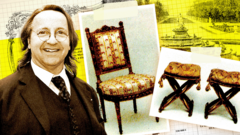In the early 2010s, the opulent French antiques market experienced a remarkable find when two ornate chairs allegedly belonging to the Palace of Versailles surfaced for sale. Said to have been once crafted for Marie Antoinette, the last queen of France, these chairs bore the seal of renowned carpenter Nicolas-Quinibert Foliot. Their historical significance and craftsmanship prompted the French government to declare them "national treasures" in 2013, coinciding with Versailles' interest in acquiring them—albeit at a price point too steep for the palace.
Instead, Qatari Prince Mohammed bin Hamad Al Thani purchased the pair for an astonishing €2 million (£1.67 million). This acquisition added to a remarkable trove of 18th-century royal furniture that had been circulating in the market. Notably, some items included those claimed to have belonged to other historical figures, such as Madame du Barry and Princess Élisabeth. Versailles managed to acquire several of these items for display in its extensive museum, while one chair ended up with the affluent Guerrand-Hermès family.
However, the winds of fortune turned in 2016 when these regal chairs were unveiled as elaborate fakes, triggering a national scandal that shook the French antiquities community. Georges "Bill" Pallot, a noted expert in 18th-century French chairs, and Bruno Desnoues, an award-winning cabinetmaker, faced trial on charges of fraud and money laundering after a nine-year investigation revealed the deception.
Galerie Kraemer and its director, Laurent Kraemer, were also implicated due to their role in selling some of these counterfeit chairs, though they maintain their innocence against claims of gross negligence. The trio's trial is set at a court in Pontoise, near Paris, following an earlier trial in March.
Originally, the scheme began in jest around 2007, when Pallot and Desnoues sought to replicate a chair they were restoring. What started as a mere experiment soon escalated into a successful endeavor where Pallot procured inexpensive wood frames from various auctions, while Desnoues expertly aged newer wood to create authentic-looking replicas. Their successful forgeries found their way into auction houses such as Sotheby's and Drouot, leading to an estimated profit of over €3 million.
The scale of their deceit was exacerbated by Pallot's privileged academic access to archival records from Versailles, which facilitated the creation of items that seemed to belong in the historical collection. Lawyers representing Versailles argued that this intricate web of deceit undermined the institution’s reputation, emphasizing the necessity for stringent regulations in the art market to curb similar fraudulent activities.
The investigation intensified when authorities noticed the lavish lifestyle of a middleman involved in the scheme, leading to the exposure of the whereabouts of Pallot and Desnoues. While many initial charges against other collaborators were dropped, the legal case against Kraemer and his gallery proceeded, with prosecutors highlighting their neglect in verifying authentication before selling high-priced items.
In their defense, Kraemer’s legal team asserted their client's unawareness of the counterfeit nature of the furniture, arguing that the gallery, like Versailles, was a victim of the fraud. The upcoming court ruling could potentially reshape standards regarding the verification of antiques, raising significant questions about the mechanisms in place to protect collectors and institutions from imposters.
As attention shifts toward this ongoing legal saga, the fallout from the furniture fraud highlights the imperative for enhanced scrutiny in the art world, an arena where trust and authenticity are paramount.



















